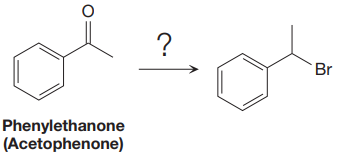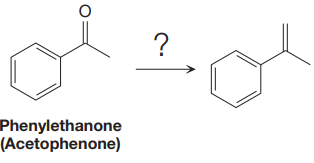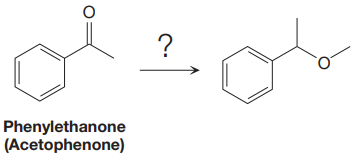
Concept explainers
(a)
Interpretation:
The synthesis of given compound from
Concept introduction:
In an
Answer to Problem 17.66P
The synthesis of given compound from

Explanation of Solution
The given reaction is,

The first step of the reaction is reduction of
The synthesis of given compound from

The synthesis of given compound from
(b)
Interpretation:
The synthesis of given compound from
Concept introduction:
The
Answer to Problem 17.66P
The synthesis of given compound from

Explanation of Solution
The given reaction is,

In the first a new C-C bond is formed and a methyl group is added to the carbonyl carbon. Both alkyllithium reagents and Grignard reagents can react rapidly with water in a substantially exothermic proton transfer reaction to produce an alkane and
The synthesis of given compound from

The synthesis of given compound from
(c)
Interpretation:
The synthesis of given compound from
Concept introduction:
In an
Answer to Problem 17.66P
The synthesis of given compound from

Explanation of Solution
The given reaction is,

The first step of the reaction is reduction of
The synthesis of given compound from

The synthesis of given compound from
Want to see more full solutions like this?
Chapter 17 Solutions
ORG.CHEM W/TEXT+SOLU.MANUAL
- (SYN) Show how to carry out each of the following syntheses by first converting the alcohol into a sulfonyl chloride.arrow_forward(SYN) Show how you would carry out this synthesis.arrow_forward(SYN) Show how each of the following compounds can be synthesized from an acid chloride and either water, an alcohol, or an amine. For each reaction, provide the complete, detailed mechanism.arrow_forward
- Major product and mechanism? Give handwritten answerarrow_forwardPlease answer both , Do not give incomplete solution , if u hv plan to do 1 then leave lets some other do . GIVE MECHANISM FOR BOTH GIVE IUPAC NAME OF PRODUCTS IDENTIFY MAJOR OR MINOR WITH REASON. please do not miss any point given in above , please do all i will upvotearrow_forwardPlease answer question below, be very deatiled and draw out the mechanism reaction with arrowsarrow_forward
- (SYN) Show how you would synthesize each of these compounds, using butan-1-ol and benzene as your only sources of carbon.arrow_forwardprovide full and detailed reaction mechanism given the following reactants, products and conditionsarrow_forwardprovide the detailed mechanism for the given reactions. Do not skip any steparrow_forward
 ChemistryChemistryISBN:9781305957404Author:Steven S. Zumdahl, Susan A. Zumdahl, Donald J. DeCostePublisher:Cengage Learning
ChemistryChemistryISBN:9781305957404Author:Steven S. Zumdahl, Susan A. Zumdahl, Donald J. DeCostePublisher:Cengage Learning ChemistryChemistryISBN:9781259911156Author:Raymond Chang Dr., Jason Overby ProfessorPublisher:McGraw-Hill Education
ChemistryChemistryISBN:9781259911156Author:Raymond Chang Dr., Jason Overby ProfessorPublisher:McGraw-Hill Education Principles of Instrumental AnalysisChemistryISBN:9781305577213Author:Douglas A. Skoog, F. James Holler, Stanley R. CrouchPublisher:Cengage Learning
Principles of Instrumental AnalysisChemistryISBN:9781305577213Author:Douglas A. Skoog, F. James Holler, Stanley R. CrouchPublisher:Cengage Learning Organic ChemistryChemistryISBN:9780078021558Author:Janice Gorzynski Smith Dr.Publisher:McGraw-Hill Education
Organic ChemistryChemistryISBN:9780078021558Author:Janice Gorzynski Smith Dr.Publisher:McGraw-Hill Education Chemistry: Principles and ReactionsChemistryISBN:9781305079373Author:William L. Masterton, Cecile N. HurleyPublisher:Cengage Learning
Chemistry: Principles and ReactionsChemistryISBN:9781305079373Author:William L. Masterton, Cecile N. HurleyPublisher:Cengage Learning Elementary Principles of Chemical Processes, Bind...ChemistryISBN:9781118431221Author:Richard M. Felder, Ronald W. Rousseau, Lisa G. BullardPublisher:WILEY
Elementary Principles of Chemical Processes, Bind...ChemistryISBN:9781118431221Author:Richard M. Felder, Ronald W. Rousseau, Lisa G. BullardPublisher:WILEY





